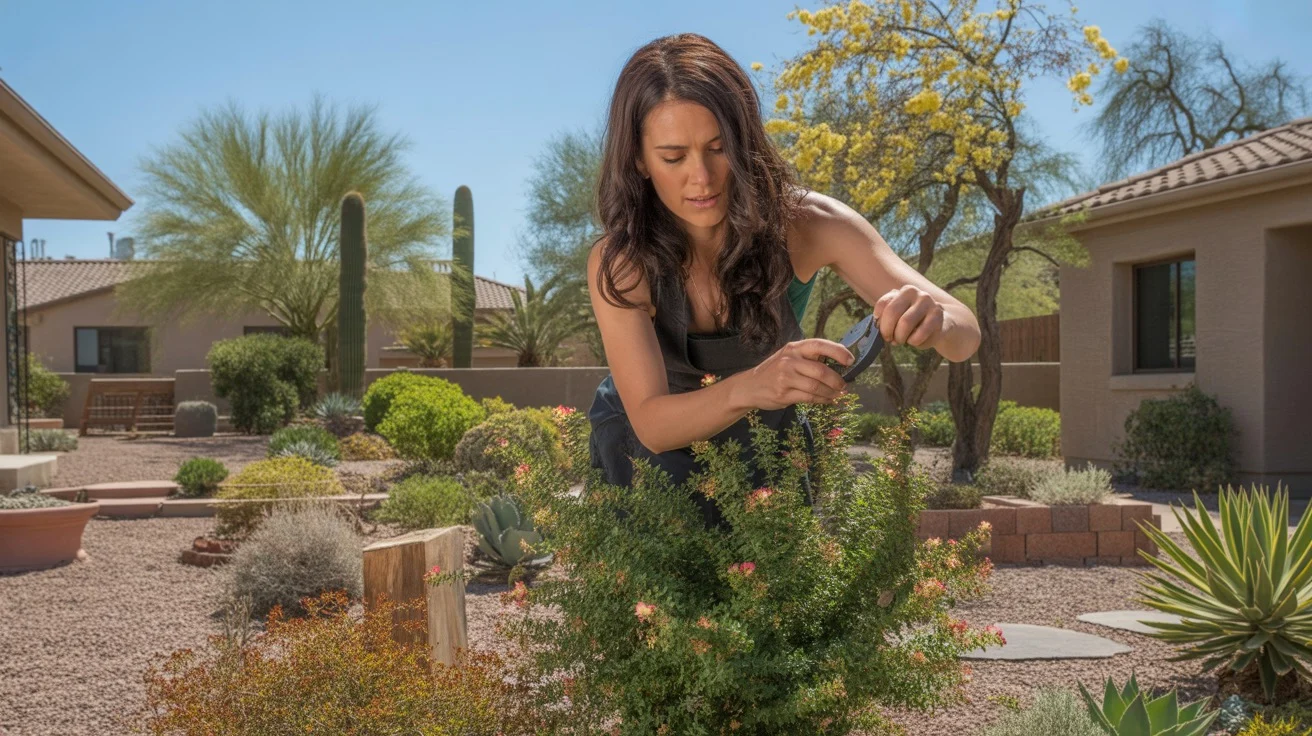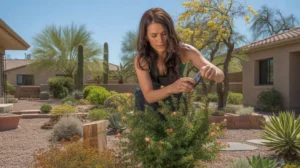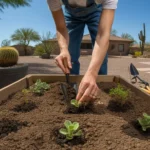As the mild days of spring arrive in Queen Creek, it’s the perfect time to awaken your garden from its winter slumber. With some targeted care and a bit of elbow grease, you can set the stage for a lush, thriving yard that will be the envy of the neighborhood. These spring gardening tips, tailored for the unique climate and conditions of Queen Creek, will help you revitalize your landscape and enjoy a beautiful desert oasis all season long.

Prune and Clean Up Winter Damage
The first step in your spring gardening checklist should be a thorough cleanup of any winter damage. Even in Queen Creek’s relatively mild winters, frost can cause browning on sensitive plants. Prune away dead or damaged branches on shrubs and trees, cutting back to healthy wood. This will direct the plant’s energy into producing fresh, vibrant growth.
For perennials that die back in winter, prune away old foliage to make way for new shoots. Rake up fallen leaves and debris, as this can harbor pests and diseases. Adding a fresh layer of mulch around your plants will help retain moisture and suppress weeds as the weather warms up.
Adjust Your Irrigation Schedule
With the increasing heat and longer days of spring, your garden’s water needs will change. It’s important to adjust your irrigation schedule to ensure your plants are getting the right amount of moisture. Over-watering can be just as damaging as under-watering, leading to root rot and fungal issues.
As a general rule, deeply water desert-adapted plants about once a week in spring, allowing the top inch of soil to dry out between waterings. For non-native plants or thirstier species, you may need to water more frequently. Installing a drip irrigation system can help deliver water efficiently right to the root zone. It’s also a good idea to water early in the morning, before the intense midday heat causes evaporation.
Fertilize for Optimal Growth
Spring is the time when plants shift into active growth mode, so giving them a nutrient boost can help support lush, healthy development. For most Queen Creek gardens, a balanced, slow-release fertilizer applied once in early spring is sufficient.
Avoid over-fertilizing desert natives like cacti and succulents, as this can cause excessive, weak growth. A light feeding of a low-nitrogen fertilizer is plenty. For flowering plants and frost-tender species, wait until all danger of frost has passed before fertilizing, typically in late February or March in Queen Creek.
Plant Heat-Loving Flowers and Veggies
While the spring planting window is short in Queen Creek, there are many colorful annuals that thrive in the increasing heat. Pentas, angelonia, gomphrena, and vinca are all low-maintenance options that will bloom profusely well into summer. Marigolds and zinnias are also reliable, bringing pops of cheery color.
For the veggie garden, spring is ideal for planting heat-loving crops like tomatoes, peppers, squash, and beans. Choose varieties well-suited to the desert, like ‘Solar Fire’ tomatoes or ‘Magdalena’ squash. Plant in amended, well-draining soil and mulch around the base to conserve moisture.
Tackle Weeds Early
Spring is when many common Queen Creek weeds like spurge, crabgrass, and goosegrass rear their ugly heads. The best defense is a good offense – tackle them early before they have a chance to take hold. Hand-pulling is effective for small outbreaks.
For larger weed issues, spot-treating with an herbicide or laying down a thick layer of mulch can help. Avoid using weed killers near waterways or on windy days. As always, prevention is key – apply a pre-emergent herbicide in late winter and maintain a dense, healthy yard to outcompete weeds.
Watch for Pests and Disease
The balmy spring weather doesn’t just spur plant growth – it can also bring out garden pests and diseases. In Queen Creek, common spring issues include aphids, thrips, and powdery mildew. Regular monitoring is crucial to catch problems early.
Many pests can be controlled with a strong blast of water or by releasing beneficial insects like ladybugs and lacewings. If an infestation gets out of hand, targeted use of horticultural oils or insecticidal soaps can help. Powdery mildew, which appears as a white coating on leaves, is best prevented by ensuring good air circulation and avoiding overhead watering.
Refresh Hardscaping and Outdoor Living Spaces
Spring is a great time to spruce up patios, walkways, and garden beds in preparation for outdoor living in the milder months. Pressure wash pavers and concrete to remove dirt and stains. Refresh rock mulch or gravel in beds and borders.
Consider adding or expanding seating areas to take advantage of Queen Creek’s beautiful spring weather. A simple decomposed granite patio surrounded by lush potted plants can create an inviting oasis. String up some lights or add a fire pit for enjoyable evenings outdoors before the summer heat arrives.
By following these spring gardening tips tailored to Queen Creek’s climate and conditions, you can revitalize your yard and enjoy a beautiful, thriving landscape all season long. With a bit of timely care and attention, your garden will awaken from its winter slumber and burst into lush, vibrant life.











